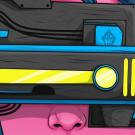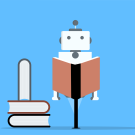
While pursuing a Master of Science degree in mechanical engineering at the University of California, Davis, Erik Contreras felt a need to reconnect with the "why" behind their engineering efforts. They took two years to get their Master of Fine Arts degree at UC Davis' Department of Design — their work was featured in a virtual graduate showcase at the Jan and Maria Manetti Shrem Museum of Art in 2021 — and forged a connection between their technical and creative sides, devising objects out of old technology to combat electronic waste, or e-waste.
Contreras is back to finish their master's degree in mechanical engineering, with a goal of making robotics and autonomous vehicles more accessible through open-source hardware and software. Contreras talks about their venture into the world of design and centering humanity in their engineering research.
You took a pause while pursuing your master's degree in mechanical engineering at UC Davis to pursue an M.F.A. in design at the university. Can you describe that journey?
I was initially attracted to manufacturing during my bachelor's degree in mechanical engineering at UC Davis. However, as I progressed through my first year in the master's program for mechanical engineering, I felt something was missing in my education: the human aspect of engineering. That realization led me to pause my master's and focus on the master's program in design, where I explored creative hacking, the right to repair and frameworks for communities to learn from engineering fundamentals.
I did a two-year program with the Department of Design, and then I spent an additional year refining my research for a public audience. I presented some of my prototypes at the Santa Monica Museum in Barcelona, Spain, as part of the 2022 International Symposium of Electronic Arts collection.
What does "hacking" mean in your area of research?
In my work, hacking refers to understanding how each component of a device functions so you can modify, repair or even repurpose it. We need to find ways to make our technology more transparent so we can have a better understanding of how the system works. That not only allows you to repair an object if it breaks, but also provides opportunities to modify your object if there's a better part that comes along.
This builds a sense of true ownership over technology. By making technology more transparent and accessible, you empower people to modify and repair their devices rather than relying on the companies that built them. I think the beauty of hacking is trying to do the most you can with the limitations that are presented to you. These types of struggles bring a lot of appreciation of the built world around us. Being able to build something with your own hands and your own ideas makes technology very human.
I find the status quo of planned obsolescence [where companies intentionally design products to have short lifespans to encourage purchases of newer models] and the use of proprietary systems to be concerning. Not only do they lead to an accumulation of e-waste on our planet, but they foster an unfair power dynamic between the producer and consumer. The effort in open-source solutions will not only alleviate these issues but also provide opportunities for improving our technical literacy, interdisciplinary work and creative outlets with our technology.

Can you elaborate on the "creative hacking" projects you worked on: the Arduino auto-typewriter and the mycelium speakers?
Both projects were rooted in my passion for sustainability and open-source technology.
The Arduino auto-typewriter was more about hacking and reusing electronic waste. The question was, "How can I connect this to a PC system?" I used an Arduino Uno, an open-source microcontroller to spoof a typewriter's microcontroller to type remotely in an effort to make it print out documents like a modern-day printer.
The mycelium speakers were part of my exploration into sustainable packaging. These are solar-powered Bluetooth speakers that you could hook up to your computer or hook up to your laptop and play; I used mycelium instead of plastic for the speaker housing, aiming to create a biodegradable alternative and a salvaged solar-powered battery bank. It's basically an environmentally friendly boombox.
You're currently working on autonomous vehicles in Assistant Professor of Mechanical and Aerospace Engineering Shima Nazari's lab for your M.S. in mechanical engineering. How does this align with your overall ethos of community and multidisciplinary collaboration?
I am leading a team of students from different departments in building an autonomous car at the 1/10th scale, using the Open Robotics software suite, including ROS2 and Gazebo [a suite of tools for building robot applications and a 2D/3D robotics simulator, respectively]. This car will be used for research in autonomous driving and collegiate F1Tenth autonomous racing competitions, hopefully this spring.
Working on autonomous vehicles is a multidisciplinary effort that involves collaboration between various departments, from mechanical engineering to computer science. I'm focusing on model predictive control for autonomous cars, but what excites me most is the people involved — undergraduates, graduate students and faculty. The teamwork and knowledge-sharing across disciplines reflect my core belief in community-driven research.

How has the master's degree in design influenced your engineering research?
The design program taught me soft skills, like bringing people from different disciplines together. For instance, in my work with autonomous vehicles, I'm collaborating with people from computer science and electrical and computer engineering — I even got some folks from design to create the logo and aesthetics of our car — to create a cohesive team.
Combining hard and soft skills leads to a collaborative space where people can work together and share these ideas and come out with a unique and special product. That encompasses a lot of the greatness that UC Davis has as a university.
How do you balance your creative projects with your engineering career goals?
My dad's philosophy is "Discipline gives freedom"; my mom was always the one to say, "Find what you're passionate about, never work a day in your life." I agree with both, and I'm really trying to find that happy medium with the engineering work I'm doing with the San Francisco Municipal Transportation Agency [or SFMTA] and my creative projects.
At the SFMTA, I am working as a mechanical engineer intern. My days are split between updating computer-aided design models of the historical cable cars, developing a velocity tracker for analyzing ride quality and making field visits to SFMTA bus depots for safety checks. I plan to focus on my Arduino auto-typewriter more next year, specifically developing a how-to guide and publishing the source code.
Regardless of where my career takes me after UC Davis, I'll still have that spark to work on these creative projects, and UC Davis has been really good at harnessing that.
This article originally appeared on the UC Davis College of Engineering website.
YOU MAY ALSO LIKE THESE STORIES

Improving Our Lives Through Design
Inside an L-shaped room in Cruess Hall, surrounded by workstations, 3D printers, sewing machines, tools and mannequins wearing prototypes, Gozde Goncu-Berk builds the future. It’s a future of many possibilities, but those possibilities share a common thread. They’re all based around humanity’s increasing use of wearable technology.

From Viruses and Materials to Galaxies and Beyond
At the College of Letters and Science at UC Davis, researchers are using the power of machine learning to help protect us from the next pandemic, discover and build new materials, and explore the myriad galaxies in the heavens above.
